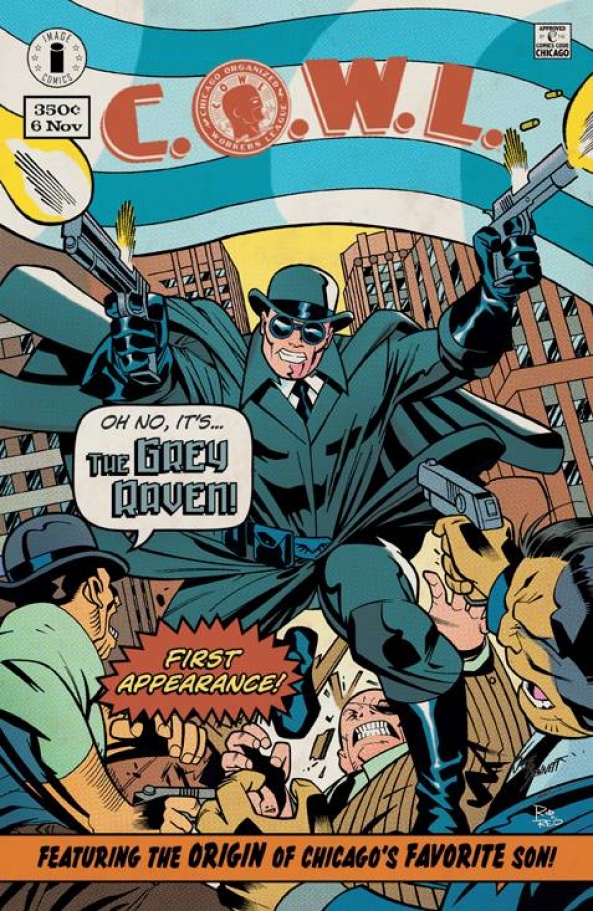In a break from the main action, “C.O.W.L.” takes a step into the past and goes deep into the origin of the series most important character, Geoffrey Warner. The result is a fun, retro style comic book that adds a new layer to the entire series.

Written by Kyle Higgins and Alec Siegel
Illustrated Elsa Charretier
NEW STORY ARC! Before he started C.O.W.L., Geoffrey Warner fought for Chicago as the city’s first hero, THE GREY RAVEN! But what started him down the path of crime fighting? Witness the origin of Chicago Superheroes, the War Years, and the formation of C.O.W.L. as told in the sellout issue written by C.O.W.L reporter and comic book writer Randall Winters
When we last left Geoffrey Warner, he was revealed making a deal with Camden to get more costumed villains on the streets of Chicago so that C.O.W.L. would continue to be needed. “C.O.W.L.” #6 takes a step out of the main story and is a complete origin of the organization’s leader Geoffrey Warner. The issue takes us all the way back to when Geoffrey was a kid who just wanted to be like his dad. Through some life lessons he found his own way in life and become the vigilante hero The Grey Raven during the 1920’s.
Initially I wasn’t as excited for this issue because the first arc ended on such a big bang that it felt like too much momentum would be lost. While there’s some of that momentum lost, this issue of “C.O.W.L.” serves a lot of purpose. Geoffrey Warner is a complex character. He doesn’t exist in a black and white world and the actions he takes aren’t easy to understand. We don’t know very much about his past or how he came to be in the position that he’s in now. Honestly, we really have no insight to the man himself. We only know the leader of C.O.W.L. Higgins and Siegel write a very compelling origin story. You can actually pick up on things that become so important later on. They also bring a sense of almost Shakespearean tragedy to the character with what sets him on the path of becoming The Grey Raven.
The origin story itself ties into the bigger story in a really interesting way because it’s not easy to believe. On one hand, if you do believe it, then you do question how deep Warner is into his own delusions. He knows exactly what he’s doing and that he’s not the idealistic young man he once was. He’s become the villain in his own comic book. This an attempt again to paint himself and C.O.W.L. as a shining beacon in Chicago. We’ve seen him do this before with the local newspapers and it’s more evidence to not only his tactics but his own delusions of what C.O.W.L. is anymore.
On the other hand if you don’t believe what we’re shown then you’ll question why we even got this information. It’s told to us from the first page that this is information Warner gave out to Image Comics for the comic book (super meta). Is Warner in his own way trying to teach us a lesson through a cute allegory? Is he in his own way he’s looking for the ‘good guys’ of C.O.W.L. to fix things even if that involves taking him out? I could be reading into this far, far too much but it’s a testament to how good this comic is when that’s what I drew from it. What could be just a cute, retro comic means so much more in the grand sense of the story.
“C.O.W.L” #6 has a stand in artist this month due to the direction of the story. Elsa Charretier takes over for Rod Reis this month and boy does she do a great job. Reis’ style didn’t fit this story and what she brings is worth the cover price alone. If I didn’t know better I’d believe this was a comic printed 70 years ago. Charretier brings such life to this world but it’s really the contrast to what we usually get that stood out most. Typical issues of “C.O.W.L.” are dark, moody and screams noir. Charretier goes in the complete opposite direction with a more cartoon like quality. This is retro “Action Comics” and within this issue we see Geoffrey Warner in a totally different view. He’s happy, full of life and full of excitement about the things happening around him. His costume and the costume of villain The Robber are campy but fits the time period perfectly. Reis does the coloring and he seems to only really use a palette that older comics used which really hits home the retro tone.
Continued belowOn top of this, and worth mentioning, are the Image Comics ads that were created by Jen Aprahamian. They reminded me a lot of what was done for the first issue of “The Fade Out”. They look like retro crime magazines and novels. I’ll go so far to say that Image Comics should use them for a variant cover month. I know I’m not the only person who wouldn’t go crazy over them.
“C.O.W.L.” #6 is not the most “new reader friendly” issue of the series and it does take a break from the action but it is still very good. “C.O.W.L.” seems to fly under a lot of people’s radar and it’s a shame. This has become something special and for my money it’s easily one of the best ongoings at Image right now.
Final Verdict: 8.6 – The origin story of Geoffrey Warner makes for one of the best single issues of the week and proves why “C.O.W.L.” is so good.



